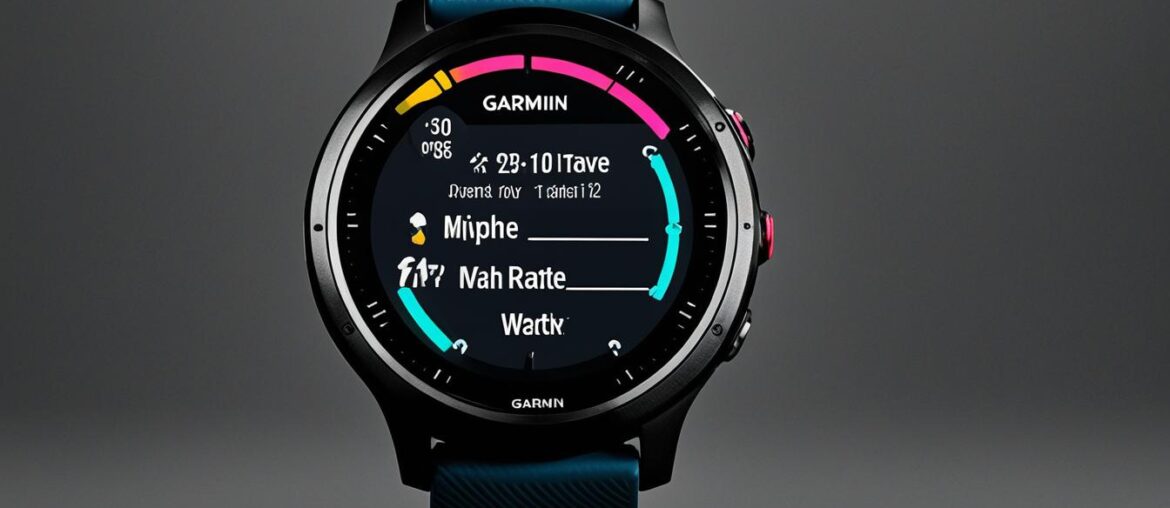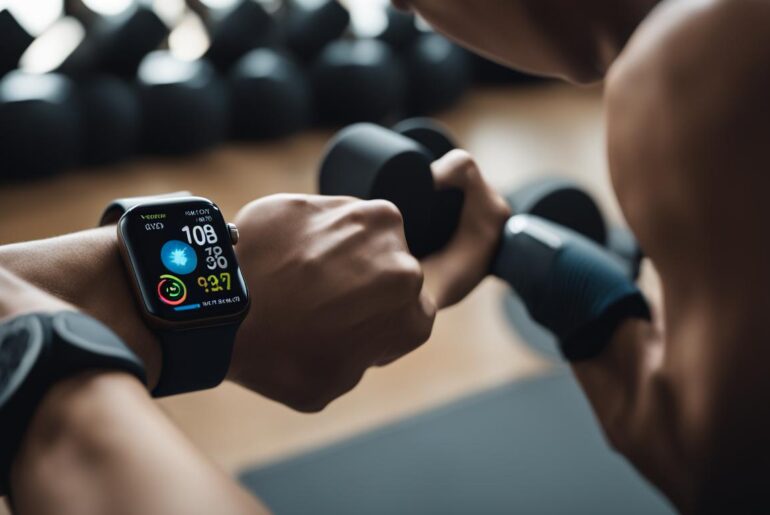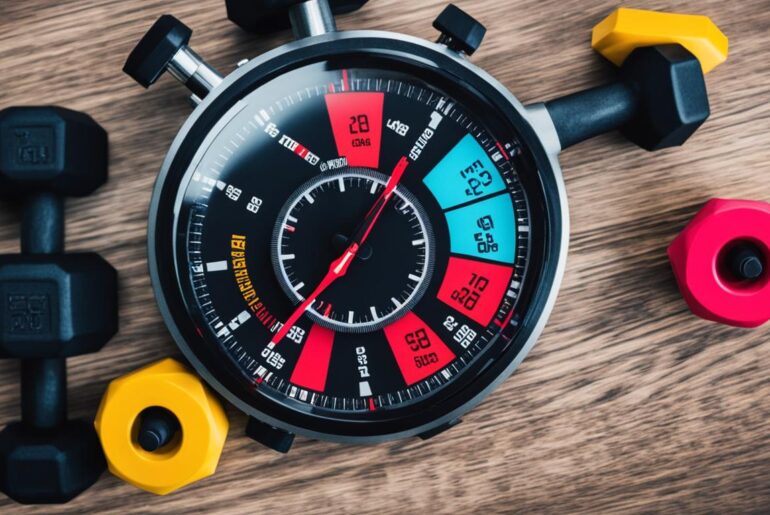The Garmin Vivoactive 3 is a versatile fitness tracking device that offers a range of features to help you achieve your fitness goals. One of its notable functionalities is the ability to track strength training workouts. Whether you’re a beginner looking to build muscle or a seasoned fitness enthusiast aiming to improve your strength, the Vivoactive 3 can be a valuable tool in your workout routine.
Key Takeaways:
- The Garmin Vivoactive 3 is a fitness tracking device that allows you to track your strength training workouts.
- By accurately recording your sets and reps, you can monitor your progress over time.
- The Vivoactive 3 offers a convenient way to track your strength training sessions, whether you’re a beginner or an experienced fitness enthusiast.
- Utilize the features of the Vivoactive 3 to optimize your strength training tracking and achieve your fitness goals.
- Stay motivated and committed to your strength training program with the help of the Vivoactive 3’s tracking capabilities.
How to Record Strength Training on Garmin Vivoactive 3
If you want to accurately record your strength training sessions on the Garmin Vivoactive 3, follow these simple steps:
- Access the Strength Training Activity: On your Vivoactive 3, navigate to the “Activities” menu and select “Strength.”
- Select your Workout: Choose the appropriate workout option based on the type of strength training you’ll be performing, such as “Weights,” “Resistance Bands,” or “Bodyweight.”
- Start your Workout: Once you’ve selected your workout, press the “Start” button to begin tracking your session.
- Record each Set and Rep: After completing a set, use the touchscreen to enter the number of reps and the weight used. The Vivoactive 3 will automatically record this data.
- Rest Timer: If you need to take a break between sets, use the built-in rest timer feature to ensure accurate timing.
- Track your Progress: Throughout your workout, you can view real-time metrics on the Vivoactive 3’s display, including heart rate, calories burned, and the duration of your workout. This information gives you valuable insights into your performance and progress.
- Finish and Save: Once you’ve completed your strength training session, press the “Stop” button to end the workout. The Vivoactive 3 will prompt you to save or discard the session, allowing you to keep a record of your training.
By following these steps, you can easily record your strength training sessions on the Garmin Vivoactive 3, ensuring accurate tracking of your progress over time.
“I love how easy it is to record my strength training workouts on the Garmin Vivoactive 3. It helps me stay motivated and track my progress effectively.”
Tips for Effective Strength Training Tracking on Garmin Vivoactive 3

When it comes to strength training tracking on the Garmin Vivoactive 3, optimizing your workout tracking can make a big difference in achieving your fitness goals. Here are some helpful tips to get the most out of your strength training sessions:
- Set your workout details: Before starting your strength training session, make sure to enter the relevant details in your Vivoactive 3. This includes selecting the appropriate activity profile, setting the desired workout duration, and configuring any additional settings such as rest intervals or specific exercises.
- Focus on accurate rep counts: Pay attention to accurately tracking your repetitions during each exercise. This ensures that your training data is precise and provides an accurate reflection of your progress over time. Use the Vivoactive 3’s built-in rep counting feature or manually input your reps after each set.
- Utilize the custom exercise feature: Take advantage of the Vivoactive 3’s custom exercise feature to tailor your strength training sessions to your specific needs. Whether you’re performing unique exercises or following a specialized program, custom exercises can be added and tracked for a personalized workout experience.
- Monitor intensity with heart rate: Keep an eye on your heart rate during strength training sessions to gauge the intensity of your workout. The Vivoactive 3’s integrated heart rate monitor provides real-time data, allowing you to adjust your training intensity for optimal results.
- Review your workout summaries: After completing each strength training session, take the time to review the workout summaries on your Vivoactive 3. These summaries provide valuable insights into your performance, including metrics such as total duration, calories burned, and average heart rate. Analyzing these summaries can help you identify areas for improvement and track your progress.
By following these tips, you can optimize your strength training tracking on the Garmin Vivoactive 3 and take your workouts to the next level.
| Tip | Description |
|---|---|
| Set your workout details | Enter relevant information before starting your workout |
| Focus on accurate rep counts | Precisely track your repetitions for precise progress monitoring |
| Utilize the custom exercise feature | Create and track personalized exercises |
| Monitor intensity with heart rate | Use heart rate data to adjust training intensity |
| Review workout summaries | Analyze workout summaries for performance insights |
Remember, the Garmin Vivoactive 3 is a powerful tool for tracking and optimizing your strength training workouts. By implementing these tips, you can make the most of its features and enhance your fitness journey. Keep pushing yourself and enjoy the benefits of efficient strength training tracking.
The Benefits of Tracking Strength Workouts on Garmin Vivoactive 3
Tracking your strength workouts on the Garmin Vivoactive 3 offers several benefits:
- Accurate Progress Tracking: The Vivoactive 3 allows you to precisely record your sets and reps, providing an accurate measurement of your progress over time. This data can be invaluable in helping you track improvements in strength, endurance, and overall fitness.
- Goal Setting and Motivation: By tracking your workouts, you can set specific goals and monitor your progress towards achieving them. Whether you’re aiming to increase your maximum bench press or complete a certain number of push-ups, the Vivoactive 3 keeps you motivated by providing tangible evidence of your hard work and dedication.
- Insights and Analysis: The fitness tracking device offers detailed insights and analysis of your strength workouts. You can review metrics such as heart rate, calories burned, and workout duration to gain a better understanding of your performance and make informed adjustments to your training routine.
“Tracking your strength workouts with the Garmin Vivoactive 3 helps you stay accountable and focused on your fitness goals.”
Additionally, the Vivoactive 3 offers a variety of features that enhance the overall tracking experience. With built-in GPS, you can accurately measure and map your outdoor strength training sessions. The device is also water-resistant, allowing you to track your workouts even in the pool or during intense sweat-inducing sessions. The sleek design and comfortable fit of the Vivoactive 3 ensure that it can be worn throughout your day, seamlessly integrating fitness tracking into your lifestyle.
| Benefits of Tracking Strength Workouts on Garmin Vivoactive 3 |
|---|
| Accurate Progress Tracking |
| Goal Setting and Motivation |
| Insights and Analysis |
Understanding the Optimum Performance Training® Model for Strength Training

The Optimum Performance Training® (OPT™) Model, developed by the National Academy of Sports Medicine (NASM), is an evidence-based training system that can be utilized to guide your strength training progressions. The model consists of three main training levels: stabilization, strength, and power. Each level focuses on specific training adaptations and offers a progressive approach to building strength and performance.
To maximize your strength training progressions and achieve optimal results, it is crucial to understand the three levels of the OPT™ Model:
- Stabilization Level: This level focuses on enhancing muscular endurance and stability to improve overall movement mechanics and postural control. It involves exercises that target the smaller stabilizing muscles and emphasize core engagement. These exercises lay the foundation for proper movement patterns and injury prevention.
- Strength Level: Once a solid base of stability has been established, the strength level focuses on increasing muscle strength and developing lean body mass. This level incorporates traditional strength training exercises, such as squats, deadlifts, bench presses, and rows. The emphasis is on lifting heavier weights and targeting larger muscle groups.
- Power Level: The power level is the final stage of the OPT™ Model, where the goal is to maximize power output and enhance athleticism. This level involves explosive and dynamic exercises that involve rapid acceleration, such as plyometrics and Olympic lifts. It aims to improve speed, agility, and overall power capabilities.
By following the Optimum Performance Training® Model for your strength training progressions, you can ensure a systematic and progressive approach to building strength, improving performance, and achieving your fitness goals.
| Training Level | Focus | Key Exercises |
|---|---|---|
| Stabilization | Muscular endurance, stability, movement mechanics | Plank variations, glute bridges, stability ball exercises |
| Strength | Muscle strength, lean body mass | Squats, deadlifts, bench presses, rows |
| Power | Power output, athleticism | Plyometrics, Olympic lifts, medicine ball throws |
Incorporating Stabilization and Strength Exercises into Your Workouts
When it comes to achieving a comprehensive and well-rounded fitness routine, incorporating stabilization and strength exercises is essential. These exercises not only help improve overall strength and muscular stability but also contribute to a total-body workout experience. By including both stabilization exercises and strength exercises in your workouts, you can target different muscle groups and enhance your overall fitness level.
To help you get started, here are some recommended stabilization exercises:
- Plank: This exercise targets your core muscles, including the abdominals and lower back. Start by assuming a push-up position with your forearms on the ground. Keep your body in a straight line and hold the position for a set amount of time. Gradually increase the duration as you get stronger.
- Single-Leg Balance: Stand on one leg and maintain your balance for an extended period. This exercise helps improve stability and works your lower body muscles, including your glutes, hamstrings, and calves.
- Side Plank: Similar to the plank exercise, the side plank targets your obliques and is performed by supporting your body weight on one forearm and the side of your foot. Hold the position for a set amount of time and switch sides.
To further enhance your workout routine, it’s important to include strength exercises that target major muscle groups. Some examples of strength exercises include:
- Squats: Squats target your quadriceps, hamstrings, and glutes. Start with your feet shoulder-width apart, lower your body by bending your knees, and return to a standing position. Focus on maintaining proper form and gradually increase the weight as you get stronger.
- Push-ups: Push-ups engage your chest, shoulders, and triceps. Begin in a plank position with your hands shoulder-width apart, lower your chest towards the ground by bending your elbows, and push back up to the starting position.
- Deadlifts: Deadlifts are a compound exercise that targets your hamstrings, glutes, and lower back. Stand with your feet hip-width apart, bend at the hips while keeping your back straight, and lift a barbell or weights off the ground. Be sure to maintain proper form throughout the exercise.
By incorporating both stabilization and strength exercises into your workouts, you can achieve a well-rounded and effective total-body workout that promotes muscular stability, strength, and overall fitness. Remember to start with lighter weights and gradually increase the intensity as your strength improves.
| Exercise | Muscle Groups Targeted |
|---|---|
| Plank | Core (abdominals, lower back) |
| Single-Leg Balance | Glutes, hamstrings, calves |
| Side Plank | Obliques |
| Squats | Quadriceps, hamstrings, glutes |
| Push-ups | Chest, shoulders, triceps |
| Deadlifts | Hamstrings, glutes, lower back |
Creating an Effective Strength Training Program with the Garmin Vivoactive 3

When it comes to maximizing your strength training efforts, having an effective program in place is crucial. By utilizing the features of the Garmin Vivoactive 3, you can create a customized training plan that will help you achieve your fitness goals.
One of the first steps in creating your program is to identify your training variables. These variables include the number of sets, repetitions, and rest intervals for each exercise. By manipulating these variables, you can target specific muscle groups, improve strength and endurance, and prevent plateaus in your progress.
It’s important to note that the Garmin Vivoactive 3 allows you to easily track and monitor these training variables. With the ability to record your sets and reps, you can keep a detailed record of your workouts, ensuring you stay on track and make consistent progress.
Once you have determined your training variables and have recorded them on your Vivoactive 3, it’s time to structure your program. This involves organizing your exercises, sets, and reps in a systematic manner to ensure balanced development and avoid overtraining.
Here is an example of how you can structure your strength training program:
| Exercise | Sets | Reps | Rest |
|---|---|---|---|
| Bench Press | 3 | 8-10 | 60 seconds |
| Squat | 3 | 10-12 | 60 seconds |
| Deadlift | 3 | 6-8 | 90 seconds |
| Shoulder Press | 3 | 12-15 | 45 seconds |
Remember, this is just an example, and your program should be tailored to your specific goals and fitness level. It’s also important to regularly review and adjust your program as you progress to ensure continued improvement and prevent stagnation.
An effective strength training program is not only about the exercises you perform but also about proper nutrition, rest, and recovery. Be sure to fuel your body with nutritious foods, prioritize adequate sleep, and give yourself time to recover between workouts.
With the Garmin Vivoactive 3 as your training companion, you have the tools to create an effective strength training program and track your progress along the way. Take advantage of its features and design a program that will help you reach new levels of strength and fitness.
Whether you’re a beginner looking to get started or a seasoned fitness enthusiast aiming to take your strength training to the next level, the Garmin Vivoactive 3 is the perfect companion to guide and track your workouts. Start creating your effective strength training program today and unlock your full fitness potential.
Conclusion
In conclusion, the Garmin Vivoactive 3 provides a comprehensive solution for tracking your strength training workouts. With its user-friendly interface and advanced features, such as accurate set and rep recording, the Vivoactive 3 allows you to monitor your progress and optimize your workout tracking.
Whether you’re just starting out on your fitness journey or looking to take your strength training to the next level, the Garmin Vivoactive 3 is a reliable companion. By following the steps outlined in this guide, you can ensure that every rep counts and that you’re getting the most out of your workouts.
Start tracking your strength training sessions with the Garmin Vivoactive 3 today and experience the benefits firsthand. With its intuitive design and powerful tracking capabilities, the Vivoactive 3 will help you achieve your fitness goals and progress towards a stronger, healthier you.




